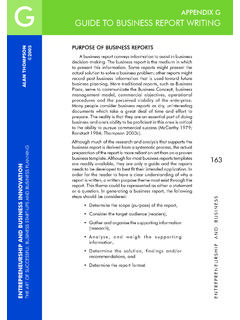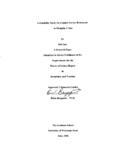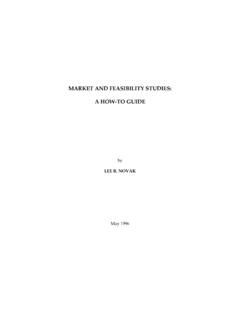Transcription of HI BUSINESS FEASIBILITY STUDY OUTLINE APPENDIX I
1 HAPPENDIX IBUSINESS FEASIBILITY STUDY OUTLINE ENTREPRENEURSHIP AND BUSINESS 185 IENTREPRENEURSHIP AND BUSINESS INNOVATIONTHE ART OF SUCCESSFUL BUSINESS START-UPS AND BUSINESS PLANNINGALAN THOMPSON 2005 WHAT IS A FEASIBILITY STUDY A BUSINESS FEASIBILITY STUDY can be defined as a controlled process for identifying problems and opportunities, determining objectives, describing situations, defining successful outcomes and assessing the range of costs and benefits associated with several alternatives for solving a problem. The BUSINESS FEASIBILITY STUDY is used to support the decision-making process based on a cost benefit analysis of the actual BUSINESS or project viability. The FEASIBILITY STUDY is conducted during the deliberation phase of the BUSINESS development cycle prior to commencement of a formal BUSINESS Plan. It is an analytical tool that includes recommendations and limitations, which are utilised to assist the decision-makers when determining if the BUSINESS Concept is viable (Drucker 1985; Hoagland & Williamson 2000; Thompson 2003c; Thompson 2003a).
2 THE IMPORTANCE OF A BUSINESS FEASIBILITY STUDY It is estimated that only one in fifty BUSINESS ideas are actually commercially viable. Therefore a BUSINESS FEASIBILITY STUDY is an effective way to safeguard against wastage of further investment or resources (Gofton 1997; Bickerdyke et al. 2000). If a project is seen to be feasible from the results of the STUDY , the next logical step is to proceed with the full BUSINESS Plan. The research and information uncovered in the FEASIBILITY STUDY will support the BUSINESS planning stage and reduce the research time. Hence, the cost of the BUSINESS Plan will also be reduced. A thorough viability analysis provides an abundance of information that is also necessary for the BUSINESS Plan. For example, a good market analysis is necessary in order to determine the BUSINESS concept's FEASIBILITY . This information provides the basis for the market section of the BUSINESS Plan (Bangs 2000; Hoagland & Williamson 2000; Truitt 2002; Thompson 2003b).
3 Finally, a FEASIBILITY STUDY should contain clear supporting evidence for its recommendations. The strength of the recommendations can be weighed against the STUDY ability to demonstrate the continuity that exists between the research analysis and the proposed BUSINESS model. Recommendations will be reliant on a mix of numerical data with qualitative, experience-based documentation. A BUSINESS FEASIBILITY STUDY is heavily dependent on the market research and analysis. A FEASIBILITY STUDY provides the stake holders with varying degrees of evidence that a BUSINESS Concept will in fact be viable (Hoagland & Williamson 2000; Thompson 2003c; Thompson 2003a; Wickham 2004). APPENDIX I - BUSINESS FEASIBILITY STUDY OUTLINE APPENDIX IBUSINESS FEASIBILITY STUDY OUTLINE ENTREPRENEURSHIP AND BUSINESS 186 IENTREPRENEURSHIP AND BUSINESS INNOVATIONTHE ART OF SUCCESSFUL BUSINESS START-UPS AND BUSINESS PLANNINGALAN THOMPSON 2005 BUSINESS FEASIBILITY STUDY AND DIMENSIONS OF BUSINESS VIABILITYThe BUSINESS FEASIBILITY STUDY findings will be assessed by potential investors and stakeholders regarding their credibility and depth of argument.
4 The BUSINESS FEASIBILITY STUDY places the findings of the Dimensions of BUSINESS Viability Model assessment into a formal BUSINESS report. It also aligns the findings with functional processes of an enterprise which an audience can easily understand (Thompson 2003a). The Dimensions of BUSINESS Viability Model is discussed in more detail in APPENDIX H titled Dimensions of BUSINESS Viability . For the purposes of understanding the structure of a BUSINESS FEASIBILITY STUDY the following represents the framework of the Dimensions of BUSINESS Viability (Thompson 2003c; Thompson 2003a): Market Viability Technical Viability BUSINESS Model Viability Management Model Viability Economic and Financial Model Viability Exit Strategy Viability BUSINESS and market analysis will contribute considerably to the BUSINESS FEASIBILITY STUDY . Consideration should be given to using traditional BUSINESS analysis techniques such as SWOT, Porters Five Forces and PEST. Although they may not provide information which is a perfect fit to the proposed BUSINESS model, they will provide a strong starting point for future FEASIBILITY STUDY OUTLINEB ecause putting together a BUSINESS Plan is a significant investment of time and money, the entrepreneur should make sure that there are no major roadblocks on their road to BUSINESS success.
5 The BUSINESS FEASIBILITY STUDY will assist in identifying such obstacles and determine the true viability of the BUSINESS Concept. IAPPENDIX IBUSINESS FEASIBILITY STUDY OUTLINE ENTREPRENEURSHIP AND BUSINESS 187 IENTREPRENEURSHIP AND BUSINESS INNOVATIONTHE ART OF SUCCESSFUL BUSINESS START-UPS AND BUSINESS PLANNINGALAN THOMPSON 2005 The following represents a structural OUTLINE for a BUSINESS FEASIBILITY STUDY : Cover SheetExecutive Summary Table of ContentsIntroductionProduct or Service Technology Market Environment Competition Industry BUSINESS Model Marketing and Sales Strategy Production/Operating Requirements Management and Personnel Requirements Intellectual Property Regulations/Environmental Issues Critical Risk Factors Financial Projections Balance Sheet Projections Income Statement Projections Cash Flow Projections Break-even Analysis Capital Requirements & StrategyRecommendations & Findings ConclusionAPPENDIX IBUSINESS FEASIBILITY STUDY OUTLINE ENTREPRENEURSHIP AND BUSINESS 188 IENTREPRENEURSHIP AND BUSINESS INNOVATIONTHE ART OF SUCCESSFUL BUSINESS START-UPS AND BUSINESS PLANNINGALAN THOMPSON 2005 EXECUTIVE SUMMARY The Executive Summary is a summary of all key sections of the BUSINESS FEASIBILITY STUDY and should work as a separate, stand-alone document.
6 Interested parties will read this section first in conjunction with a glance at the financial section when deciding whether or not they read the rest of the plan. Key points to remember include: Write this document after the content section of BUSINESS FEASIBILITY STUDY is completed. Although the Executive Summary is written last, it is presented first. The Executive Summary should be no more than one page long. PRODUCT/SERVICE Describe the enterprises, product or service in simple language. Give product mix if the enterprise will initially be focusing on more than one product. Describe how customers would use and buy the product or service. Give enough detail to help the reader judge the effectiveness of your marketing and positioning plans. Describe key components or raw materials that will be used in the product, how the enterprise will source these and how available they are. Describe plans to test the product to ensure it works as planned and is sufficiently durable, rugged, secure, etc.
7 ( consumer product test, beta test with major company, etc.). Describe plans to upgrade product or expand product line. TECHNOLOGY As necessary, provide further technical information about the product or service. Describe additional or ongoing research and development needs. IAPPENDIX IBUSINESS FEASIBILITY STUDY OUTLINE ENTREPRENEURSHIP AND BUSINESS 189 IENTREPRENEURSHIP AND BUSINESS INNOVATIONTHE ART OF SUCCESSFUL BUSINESS START-UPS AND BUSINESS PLANNINGALAN THOMPSON 2005 Keep the description in lay terms and/or explain technical terms enough to be understood by BUSINESS -savvy but not necessarily technology expert readers. INTENDED MARKET ENVIRONMENT Target Market: Define and describe the target market(s). Distinguish between end users and customers. Be clear how end users and customers benefit. How and why would they buy the product or service? What is the projected need(s) your product or services fulfill so beautifully? How big is the opportunity?
8 What level of actual market demand can be measured versus projected?For BUSINESS -to- BUSINESS markets, include: What industry is the target market in, who are the key players, frequency of product purchase, replacement needs versus expansion, purchasing process Estimates of market size, initial targeted geographic area, enterprise s targeted market share. For BUSINESS -to-consumer markets, include: Demographic factors, such as income level, age range, gender, educational level, ethnicity. Psychographic factors. Relevant behavioural factors such as frequency of product purchase and shopping behaviour. APPENDIX IBUSINESS FEASIBILITY STUDY OUTLINE ENTREPRENEURSHIP AND BUSINESS 190 IENTREPRENEURSHIP AND BUSINESS INNOVATIONTHE ART OF SUCCESSFUL BUSINESS START-UPS AND BUSINESS PLANNINGALAN THOMPSON 2005 COMPETITION Describe direct and indirect competition (as it pertains to the target markets only). For key competitors, give market share, resources, product and market focus, goals, strategies, strengths and weaknesses.
9 List all key barriers to entry. Describe what is unique about the enterprise s product/service compared to the competition. Make sure this is consistent with the unmet need of the target market(s). State how difficult it will be for competitors to copy the enterprise s product/service. Describe how competitors will most likely react to the enterprise s product launch and the enterprise s response strategy. Include estimates of the time it might take a competitor to copy your product or service. INDUSTRY Clearly define and describe the industry in which the enterprise operates. Include the size, growth rate, and outlook. Define key industry segments and state where enterprise fits in. Describe demand and supply factors and trends. Describe the larger forces that drive the market - innovation, cultural change, regulation, whatever. BUSINESS MODEL Describe the proposed enterprise's BUSINESS model. How will the BUSINESS generate revenue ( sell the product; charge licensing, retail sales)?
10 Will there be recurring revenue? Describe the model in enough detail to support financial projections presented later. IAPPENDIX IBUSINESS FEASIBILITY STUDY OUTLINE ENTREPRENEURSHIP AND BUSINESS 191 IENTREPRENEURSHIP AND BUSINESS INNOVATIONTHE ART OF SUCCESSFUL BUSINESS START-UPS AND BUSINESS PLANNINGALAN THOMPSON 2005 MARKETING AND SALES STRATEGY Lay out the basic marketing and sales strategies. Discuss any strategic partnership the enterprise has or is planning to form. Do they provide critical market access or other resources? What are their rights and responsibilities? Describe the distribution strategy (sell direct to customers through sales force, direct mail, or Internet; sell through manufacturers representatives, wholesalers, distributors, or retailers). Provide projected profit margin or mark-up expectations, commissions, and other expected compensation (co-op advertising, slotting fees, etc.) Describe the pricing strategy and justification.







